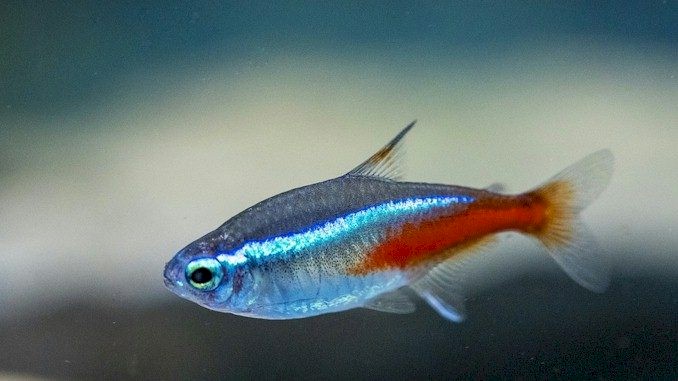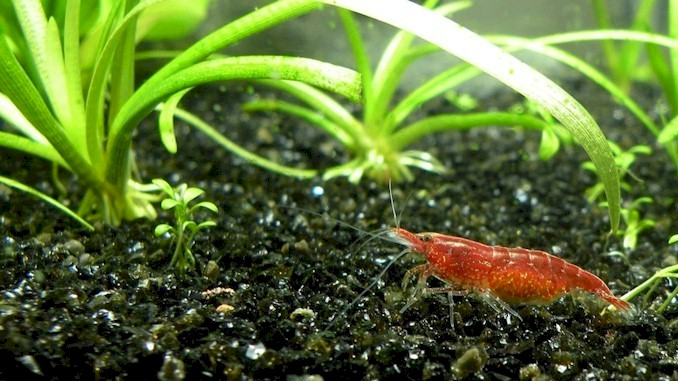How Many Neon Tetras Should You Put In a Fish Tank
When I started growing neon tetras in my fish tank, the first question I had was how many of them could I keep together. At first, my school of tetras was too small, and they didn’t live as long as they should have. Luckily, as time passed, I gained some knowledge and experience in this area.
Each neon tetra requires one and a half gallons of water, following the one gallon per inch rule. For example, you can grow up to 10 neon tetras in 15-gallons tanks and a school of 30 neon tetras in 20-gallons tanks. Naturally, overcrowded tanks can host fewer tetras and vice versa.
As we proceed, I will show you how many neon tetras you can have in 1 to 75-gallon tanks. Also, I will show you how to set up your own multiple neon tetras tank, including the water requirements and vegetation.
How Many Neon Tetras Should Be Kept Together?
Neon tetras are social creatures. They are happiest in large groups. However, that happiness won’t last if the tank the neon tetras inhabit is too small. Overcrowding is associated with stress, disease, and even death.
For that reason, I recommend that you ensure your home aquarium is large enough to house the neon tetras you want to raise. Fortunately, most aquarists use the same formula to calculate tank size. Basically, you need one gallon of water for every inch of fish. The fact that this formula is so frequently quoted proves that it works.
If you know the average size of a particular species, you can use this formula to determine the gallons required for the specific number of fish you want to house. For instance, neon tetras have an average size of 1.5 inches. As such, this is what you can expect:
Small-Sized Fish Tanks:
- 1-Gallon tanks cannot hold neon tetras.
- 2-Gallon tanks can hold one neon tetra.
- 2.5-Gallon tanks can hold one neon tetra.
- 3-Gallon tanks can hold two neon tetras.
- 3.5-Gallon tanks can hold two neon tetras.
- 5-Gallon tanks can hold three neon tetras.
- 6-Gallon tanks can hold five neon tetras.
- 6.5-Gallon tanks can hold five neon tetras.
- 7-Gallon tanks can hold five neon tetras.
Medium-Sized Fish Tanks:
- 10-Gallon tanks can hold seven neon tetras.
- 15-Gallon tanks can hold ten neon tetras.
- 20-Gallon tanks can hold 13 neon tetras.
- 29-Gallon tanks can hold 20 neon tetras.
- 30-Gallon tanks can hold 20 neon tetras.
Large-Sized Fish Tanks:
- 36-Gallon tanks can hold 24 neon tetras.
- 37-Gallon tanks can hold 24 neon tetras.
- 38-Gallon tanks can hold 25 neon tetras.
- 40-Gallon tanks can hold 26 neon tetras.
- 55-Gallon tanks can hold 36 neon tetras.
- 60-Gallon tanks can hold 40 neon tetras.
- 75-Gallon tanks can hold 50 neon tetras.
A tank of 30 gallons is perfect because it can accommodate a large group of neon tetras that have plenty of room to explore. Twenty gallons is good if that is all you can afford. However, if you have the financial means, you should aim for 30 gallons or more.
It should be noted that the formula above is primarily applicable to slender fish. With medium-sized species, people assign 2 gallons of water per inch of fish. That figure jumps to 3 gallons of water per inch of fish for large species.
The formula accounts for a mature neon tetra. Some people buy tanks with the intention of catering to the size of young neon tetras. But that is a mistake. As the neon tetras mature, they will eventually outgrow the tank. That is why I suggest buying your aquariums with the sizes of adult fish in mind.
How Many Neon Tetras Should Be In a School
There should be at least six neon tetras in a school. However, keeping between 15 to 20 neon tetras in a group accommodated in tanks of at least 30 gallons is ideal. These numbers will allow the fish to swim as one unit and assist one another when predators are nearby.
In other words, the number of neon tetras depends on the size of your tank. A group of 4 fish sounds reasonable, but it is too small. If you don’t have space, six is the minimum. But if you have room, aim for 15 to 20.
You need a minimum of 20 gallons to house them. But that is the only way to keep the individual neon tetras happy. As was mentioned above, some neon tetras in the wild live in groups with thousands of members.
Therefore, the bigger the group, the happier the neon tetras will be. But again, you must ensure that the tank is large enough to accommodate the neon tetras. Many aquarists believe that 5 gallons are the smallest tank you can use to hold neon tetras. But it is safer to aim for 10.
A 5-gallon tank is pretty challenging to maintain. Though, if all you have are 5 gallons, you should take precautions to prevent the water chemistry in the tank from changing dramatically.
That includes doing weekly maintenance, using an efficient filter, carrying out water changes every week, cutting back on the amount of food you add to the tank (to prevent the fish from producing excessive quantities of waste), and keeping a close eye on the parameters.
You can save yourself a lot of time by simply investing in a 55-gallon tank. The conditions in large tanks are pretty stable unless the aquariums in question are overstocked. Either way, I will show you how to grow multiple neon tetras in the last part of this article.
Can You Keep A Single Tetra
You shouldn’t keep a single tetra in a fish tank. Neon tetras are schooling fish, and therefore, are supposed to live in groups. In the wild, some of those groups can consist of thousands of fish. Trying to grow one tetra in a fish tank will end up with a stressed, vulnerable fish.
Schooling provides protection. Neon tetras feel safe when you place them in groups, and for good reasons. They know that predators will have a more difficult time picking out individual fish to attack whenever they encounter a group.
Additionally, because of how they move, predators may mistake a school of neon tetras for a larger fish. When you force them to live alone, they cannot take advantage of the defensive benefits of schooling.
This creates anxiety in the creatures because they no longer feel safe. That anxiety can produce stress and depression down the line. Stressed neon tetras are more vulnerable to diseases. They are also more likely to die as a result.
The only way to help lonely neon tetras is to give them companions. In most cases, neon tetras prefer to school with other neon tetras. But they may also join groups with other species that look like them. One example is the cardinal tetra which is just as small and brightly colored as the neon tetra.
How to Set Up a Multiple Neon Tetras Tank
Setting up a tank for a group of neon tetras involves the following:
Pick The Right Tank
The first step is to get a tank. I suggest starting with 20 gallons. This gives you plenty of room to experiment. Try not to buy anything smaller than 10 gallons. You need a tank that can comfortably hold six or more neon tetras at the same time.
Adjust Your Filter
Every tank requires a filter. The strength of the filter should match the size of the tank. The larger the aquarium, the more powerful the filter required. The filter will keep the water pure. However, because neon tetras are so small, you are encouraged to cover the filter’s intake with mesh.
Otherwise, the filter may suck the neon tetras in, harming or killing them in the process. The water flow rate is also essential. Neon tetras prefer a slow to medium current. Anything more substantial will exhaust them.
Set The Right Water Parameters
When it comes to neon tetras, it is best to maintain a temperature of 70°F to 78°F. Also, the pH should be between 6.0 and 7.0, and the water should have a hardness less than 10dGH.[8] Lastly, the ammonia, nitrates, and nitrites should be around 0 ppm.
On that matter, I highly recommend getting the API FRESHWATER MASTER TEST (link to Amazon). That bundle accurately measures the pH, ammonia, nitrates, and nitrites in the tank. It also lasts for an impressive number of 800 measures, turning it highly cost-effective.
If you find the water too acidic, or if the toxins are elevated, I recommend performing more frequent water changes. As a rule of thumb, replace 15 to 20 percent of the water weekly. That is especially true for relatively overstocked tanks.
When it comes to temperature, I personally use the Cobalt Aquatics Flat Neo-Therm Heater (link to Amazon). Frankly, that is the only device that kept my temperature stable enough to grow the most delicate creatures.
The water hardness can be easily measured with the 9 in 1 Aquarium Test Strips (link to Amazon). This kit will also measure your pH, nitrites, and nitrates. However, while it is pretty similar to the API test kit in performances, it only lasts for 150 measures.
You should spend the first four weeks or more cycling the tank. The process introduces bacteria that can process ammonia, converting it into less toxic components. Neon tetras cannot survive in a tank that hasn’t been fully cycled.
Place a Few Plants In The Tank
Neon tetras prefer to live in tanks with plants. You can use live or artificial plants to create a conducive environment for the creatures. You can also add objects such as driftwood and caves.
If you wish to grow live plants, some suitable choices for neon tetras would be Java Fern, Anubias, and Amazon Sword. These are all pretty easy to maintain and grow without problems.
Add Your Neon Tetras
Once your tank is ready, you should leave it running for a few days. Keep testing the water. If everything looks okay, you can start adding fish. But do this gradually. Try not to throw all 20 (or whatever number of neon tetras) fish into the aquarium. The shock caused by the transition may kill them.
Instead, I recommend acclimating them. This means placing them in a sealed bag filled with the same water they lived in before you bought them from the store. Float the bag in the water of their new aquarium. This will allow the creatures to grow accustomed to the temperature. But that is only the first step.
You should also add some water from the aquarium to the sealed bag. A lot of aquarists use the drip method at this stage. This sounds like a lot of work, but it can take less than an hour. Once the new neon tetras have been exposed to the parameters in their new home, you can add them to the tank.
Conclusion
Neon tetras are very active and peaceful fish that can make good additions to your tank. They are very hardy and will not require a lot of effort on your part. With that said, neon tetras have their fair share of requirements that you must meet if you want them to thrive.
To start with, pick an aquarium of at least 10 gallons to accommodate a small group. Ideally, you should go for 30 gallons or more. This way, you can have over a school of over 20 neon tetras. The neon tetra is a highly social creature. Therefore, I highly suggest that you keep them in relatively large schools.


